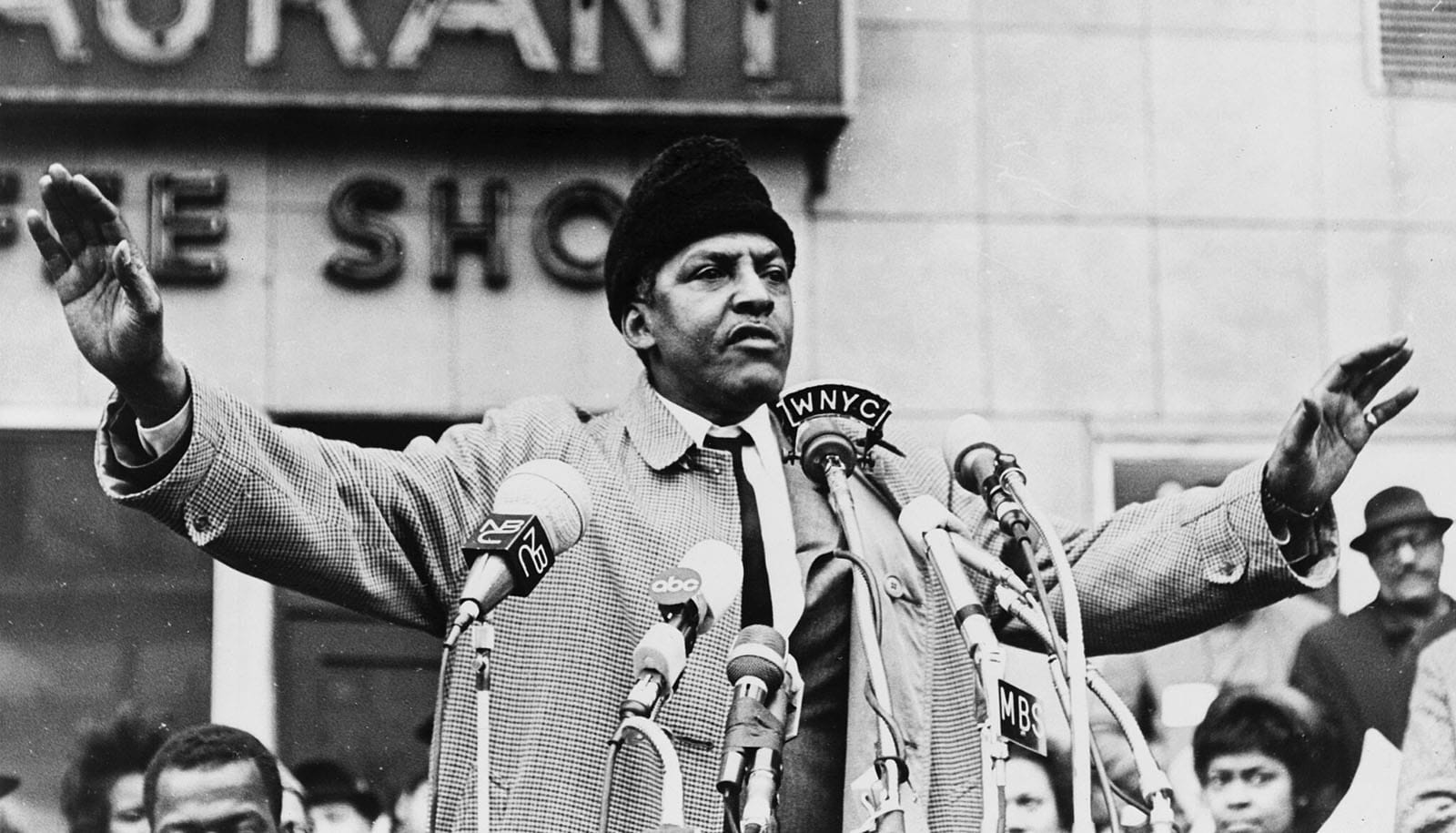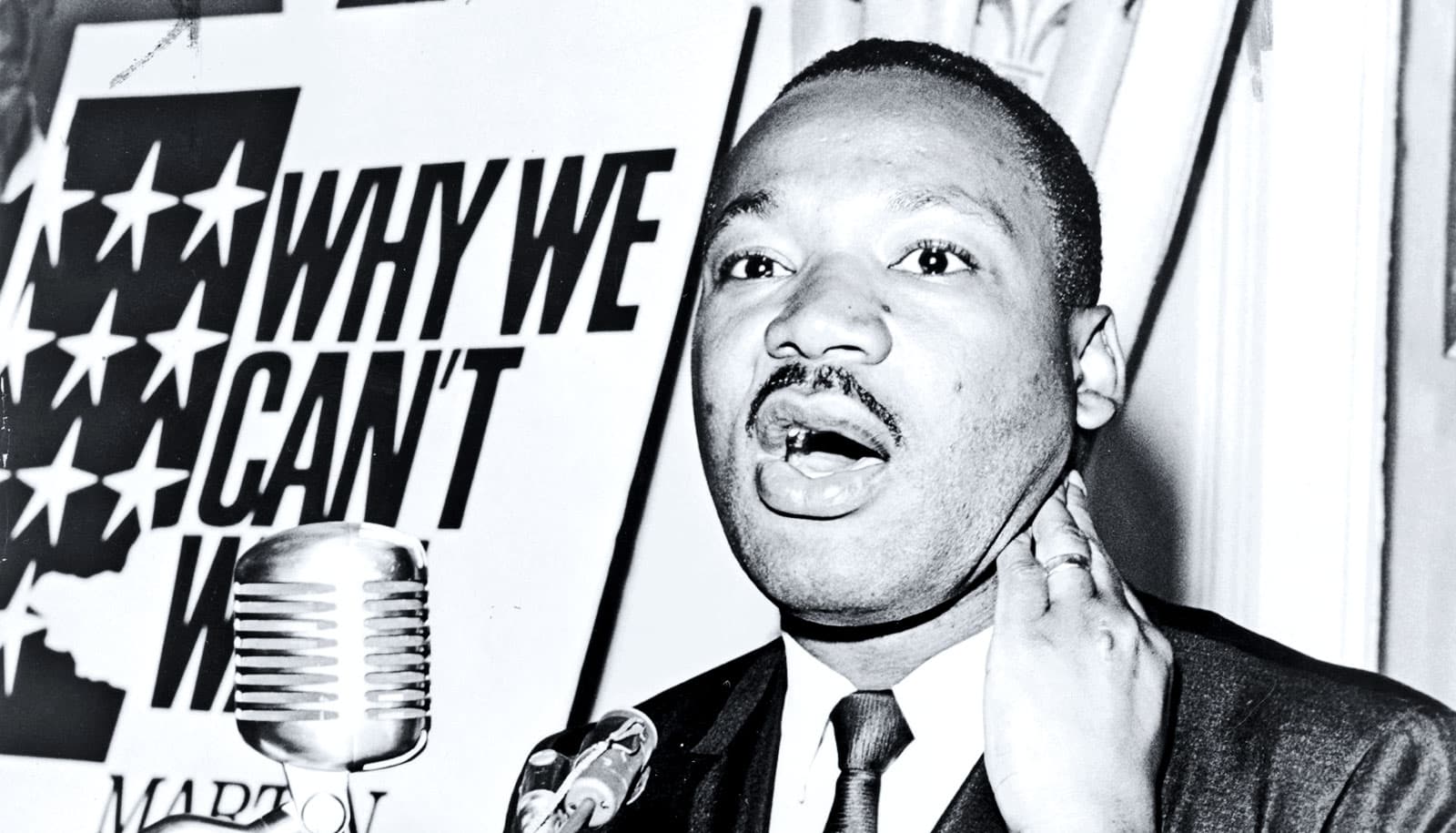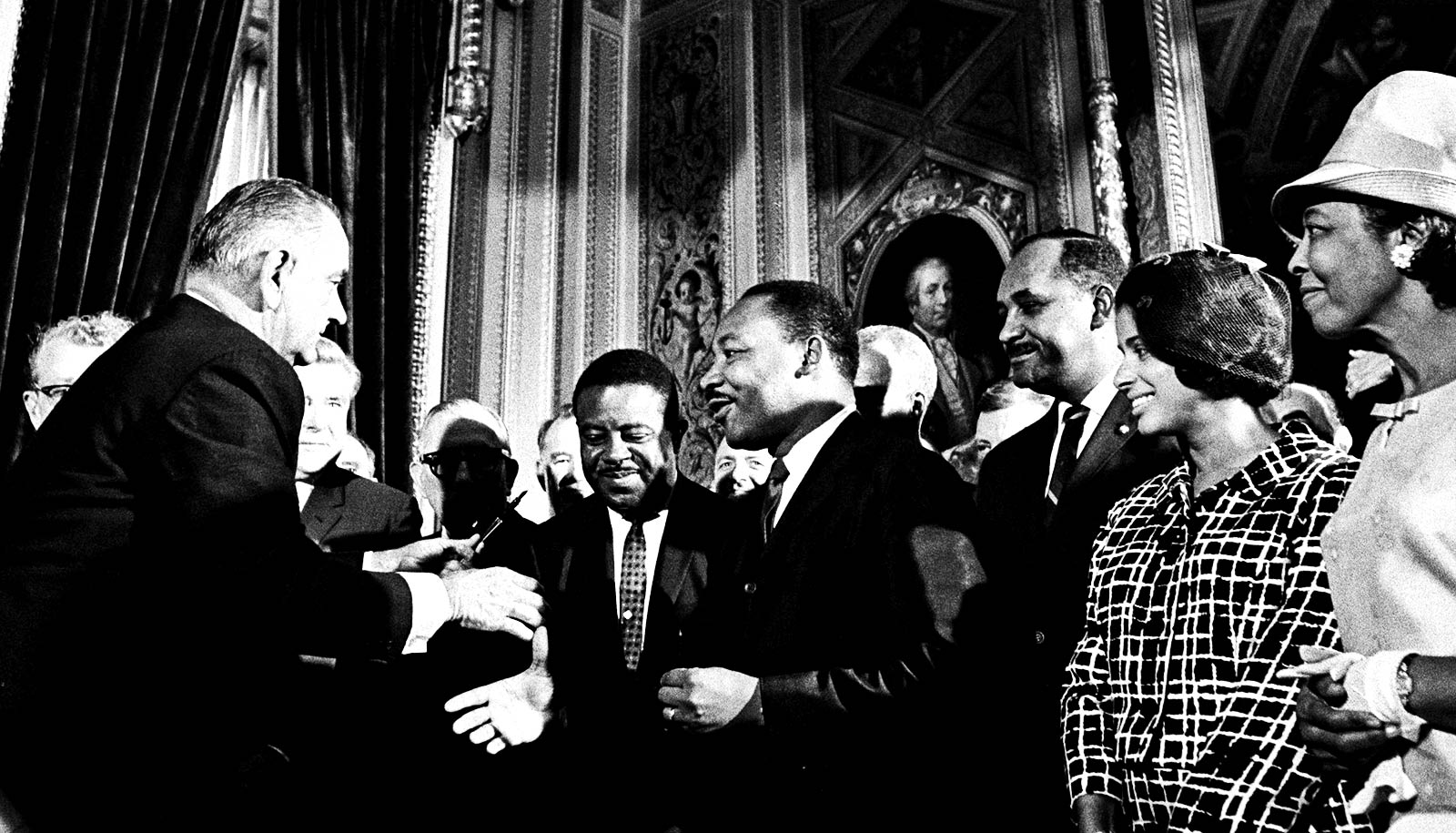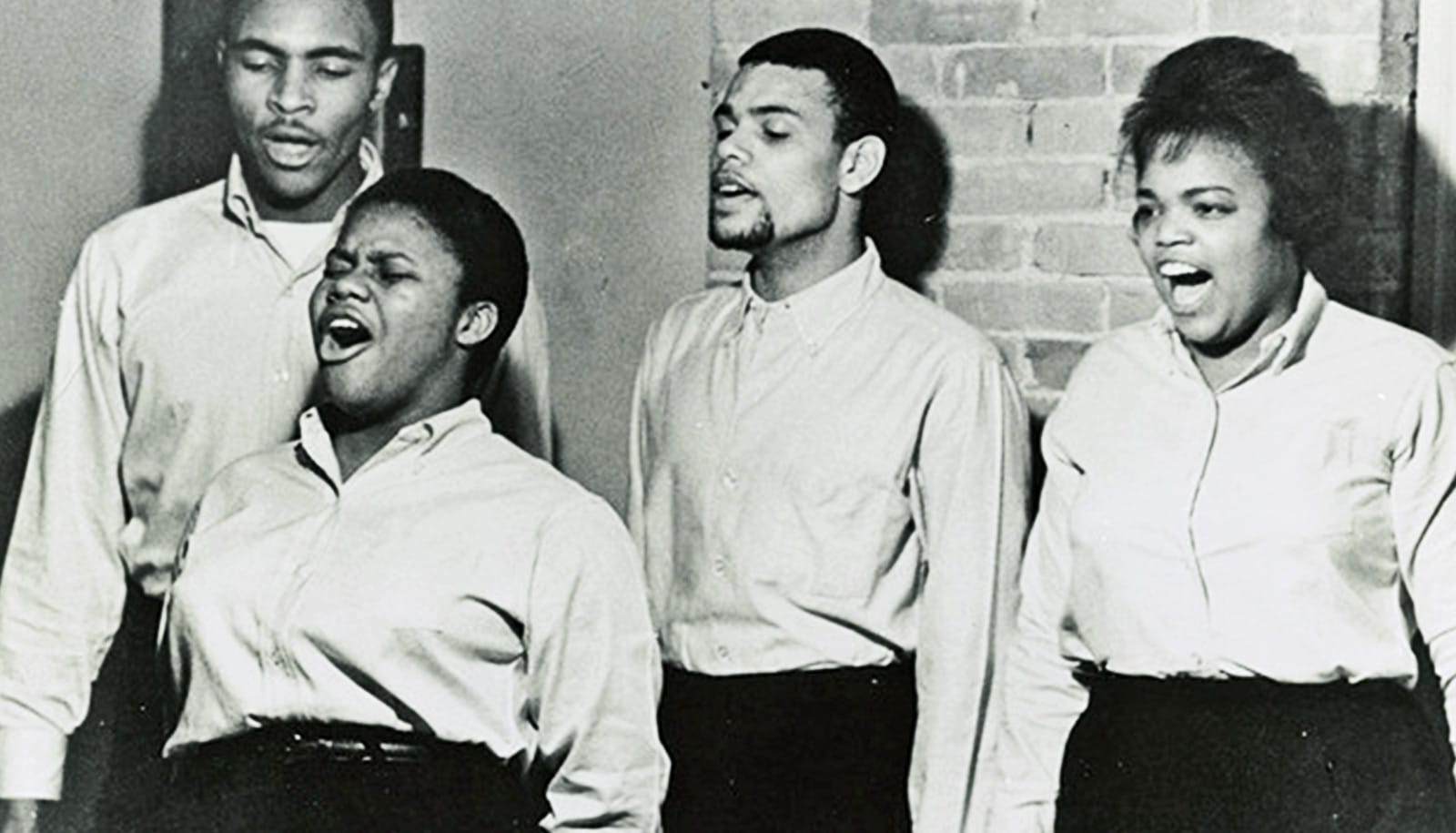A new book puts the spotlight on Bayard Rustin, an under-appreciated civil rights leader.
The face and sound of the March on Washington for Jobs and Freedom, which took place on August 28 nearly 60 years ago, undoubtedly belong to Martin Luther King, Jr. His “I Have a Dream” speech from that day has been studied, cited, and emulated around the world, with his words frequently used as a barometer for both progress and stagnation since then.
“To the extent that King’s words were about bringing an end to codified, legal segregation, then the dream has been realized,” University of Manchester sociologist Gary Younge wrote in the Nation 50 years after the March on Washington. “But to the extent that the speech was about ending racism, one can say with equal confidence that its realization is not even close.”
“Rustin changed the course of US history and he changed the course of world history. And he did this not just on August 28, 1963.”
While the long-term impact of the speech remains the subject of scrutiny, the success of the march itself was unquestionably due to the skills and experience of another civil rights leader who hasn’t always been as widely celebrated.
“No one had stronger qualifications for organizing the March on Washington for Jobs and Freedom than Bayard Rustin,” editor Michael G. Long writes in Bayard Rustin: A Legacy of Protest and Politics (NYU Press, 2023). The volume of essays examines the life and work of the pacifist strategist who introduced Gandhian tactics to the American civil rights movement and who, with King, founded the Southern Christian Leadership Conference. “It seemed as if Rustin’s entire professional career had been preparing him to become the lead organizer of the March on Washington.”
Rustin’s contributions as a civil rights leader, which also included cofounding the Congress of Racial Equality and advising King on the Montgomery bus boycott, have often been overlooked in popular understanding of the March on Washington and in civil rights history in general.
“This is partly because journalists and scholars have followed the lead of Rustin’s colleagues, who were uncomfortable with his gay sexuality and attempted to keep him in the shadows,” Long observes.
Slowly, thanks to the work of Long and other scholars, including in particular those who have sought to highlight LGBTQ+ figures whose contributions have often been excluded from the historical record, Rustin’s leading role in the march and the movement is being restored to popular consciousness.
In November, Netflix will release Rustin, a film directed by George C. Wolfe (Ma Rainey’s Black Bottom) and starring Chris Rock, Audra McDonald, and Colman Domingo (Lincoln), who plays Rustin. Michelle and Barack Obama are among its executive producers.
Here, Long, who has authored and edited multiple books on both Rustin and Jackie Robinson, who broke Major League Baseball’s color barrier in 1947, talks about the March on Washington’s lesser-known aspects and the forces that shape our understanding of history:
Because he was openly gay and had past ties to the Young Communist League, Rustin nearly became a victim of what we might call “cancel culture” today—other civil rights leaders sought to remove him as a lead organizer of the March on Washington. How would the demonstration have been different had he been removed?
It is difficult to imagine the march without Rustin as its main organizer. He was the glue that held everything together. And had he been removed, I suspect the march would have collapsed or that it wouldn’t have happened on August 28, 1963. Rustin had just eight weeks to plan the march. But Rustin could carry out this plan on such a tight deadline because he had a wealth of experience. He had already organized three marches in Washington—in 1957 to organize the Prayer Pilgrimage for Freedom, which really launched Martin Luther King onto the national stage, and then in 1958 and 1959, he organized youth marches for integrated schools. And there’s another key factor here—Rustin’s staff also included two key people who had helped to organize those protests. One was Tom Kahn and the other was Rachelle Horowitz. So all three of them could draw from their nuts-and-bolts knowledge from those earlier marches to plan the 1963 march.
Both conservatives and progressives have cited MLK’s “I Have a Dream” speech given that day. But, as you write, “one of the most overlooked parts of the march is its radicalism.” What was radical about it?
Our popular understanding of the march is very narrow, which our understanding of history tends to be. This overlooks elements that were radical and those that were notably less so.
Several march organizers, including Rustin and A. Philip Randolph, were democratic socialists. And these leaders believed that it wasn’t enough for the civil rights movement, as led by King, to focus only on racial desegregation—on desegregating buses and trains and restrooms and restaurants, and even schools. They believed that if the civil rights movement wanted total freedom for Black people, it had to start focusing on making massive changes to an economy that discriminated against Black people. And this meant that the movement had to start fighting for jobs with decent wages.
One of the long-forgotten parts of the march was its radical demand for a national minimum wage of no less than $2 per hour. Now, let me tell you how radical that was. Accounting for inflation, that translates to more than $19 per hour in today’s market. That is at least $4 more than the “Fight for $15” campaign and it’s at least $2 more than Socialist Senator Bernie Sanders’s recent call for $17 per hour.
In addition, in his speech that day, Randolph made the case for transforming our capitalist economy into a socialist one that meets the basic needs of all people. Randolph wasn’t a great orator by any stretch of the imagination, but the content of his speech was really radical. He called for an economy that was not built on a profit motive. He called for an economy that did not extoll private property over other values. In some ways, his speech packed more of a punch than any other speech that day, perhaps except for the one given by John Lewis, who was the leader of the Student Nonviolent Coordinating Committee (SNCC) at the time. In his passionate speech, Lewis called for a civil rights bill that would ensure economic equality between domestic workers, who earned something like $5 a week at the time, and the wealthy families that they worked for. Now, that type of equality would have required a socialist revolution. These are some of the forgotten and radical parts of the March on Washington.
But the march wasn’t altogether radical. Black women leaders like Pauli Murray, Anna Arnold Hedgemen, and Dorothy Height of the National Council of Negro Women had lobbied for a woman—one woman—to be one of the main speakers at the March on Washington, and they failed to persuade its all-male Big Ten leadership to make room.
Children were also excluded from speaking at the march, which still blows my mind because their involvement in the Birmingham campaign in May of 1963—when they faced off against snarling German shepherds and high-pressure hoses—is what inspired thousands of people to participate in the March on Washington. But march leaders gave them no voice at all. In fact, guidelines called for marchers to leave behind young people who were 14 and younger.
And then finally, young militants in SNCC and elsewhere ridiculed the march as being “respectable” rather than radical. They wanted the march day to include acts of civil disobedience that would fill up the halls of Congress, that would tie up traffic, and that would shut down local airports. And that didn’t happen because Rustin wanted to focus on numbers, and he knew that if they included acts of civil disobedience, they simply wouldn’t get the same turnout. Acts of civil disobedience usually attract just the hardcore few. A rally would be far more attractive to the masses.
The March on Washington has been seen as a model for future civil rights movements—notably, for LGTBQ+ rights. How did Rustin’s role as the lead organizer pave the way for the activism that followed?
Jack Nichols was a gay man who attended the march with a handful of people from the Mattachine Society of Washington. This was an organization that was devoted to securing civil liberties for gay men and lesbian women. Nichols later said that as he listened to Dr. King’s speech, he imagined that the Mattachine Society and its allies would one day march for gay and lesbian rights.
And that’s what Rustin’s march did. It inspired future activists to imagine—to imagine marching for their own rights, for their own freedom, and not just for other people’s rights and other people’s freedoms. And sure enough, less than two years later, Jack Nichols and members of the Mattachine Society of Washington marched on the White House for what they called “homosexual rights.”
Rustin’s work also showed future activists the importance of numbers. And this is an important point. Rustin understood that it was one thing to round up a couple hundred of hardcore activists for civil rights for acts of civil disobedience, and that it was another thing to bring together 250,000 people in a mass demonstration. There was power in numbers. Rustin got that. And this massive march made it impossible for the White House and Congress and politicians everywhere to ignore its demands. So this march pushed the issues of jobs and freedom onto the national stage in ways that small acts of civil disobedience never could have. And future activists took notice of the power of numbers that day and they sought to replicate that in future marches.
Rustin’s work also demonstrated the importance and power of building coalitions. The March on Washington was, yes, primarily a march by Black Americans, but it was also a march that included White union workers and religious people from various faith communities. And because of that coalition, 250,000 people showed up. Rustin and Randolph combined race and class in ways that nobody else had done up to that point.
You’ve studied the lives of both Rustin and Jackie Robinson—two men with very different public personas. But they were both civil rights leaders. How did they work together, and what did their activism have in common?
Rustin recognized that Robinson had immense star power—everyday people, not only in the United States, but across the globe, could recognize him and they were inspired by him. Rustin also knew that beginning in 1957, Robinson had taken an active role in the NAACP. So with this in mind, Rustin appealed to Robinson to help lead the 1958 and 1959 youth marches for integrated schools in Washington, DC. Robinson jumped at the chance. Robinson was always attracted to helping students advance their cause, and especially students of color to advance the cause for Black freedom.
What are the common threads between their types of activism? Well, both were thoroughgoing integrationists and both were committed to nonviolence in civil rights protests. Now, Robinson was not a pacifist. Unlike Rustin, Robinson wasn’t even close to being a pacifist, but he did affirm the importance of peaceful protests. And because of this, both men shared an interest in speaking out against Malcolm X, especially when Malcolm X called for Black separatism and when he extolled the use of any means necessary in the protection of Black lives.
They also, along these same lines, shared a common interest in critiquing the Black Power movement that emerged in 1966. Stokely Carmichael, H. Rap Brown, and others took their cues from Malcolm X in calling for Black separatism and the use of any means necessary.
Once again, Robinson and Rustin joined forces in opposing the Black Power movement. For Robinson, Black power was about the ballot and the buck—exercising your right to vote and exercising your right to be an entrepreneur and to gain a slice of the US economy.
Rustin, by the way, was an official pallbearer at Robinson’s funeral in 1972. They were close. They were close in their approaches to civil rights and they were close in what they saw were the proper goals of the civil rights movement.
Hollywood has repeatedly portrayed both the civil rights movement and the March on Washington over the years, with Netflix’s Rustin to open in November. How do these works illuminate and, conversely, perhaps warp our understanding of the period?
I’ve thought about this quite a bit, especially since 42, the movie about Jackie Robinson, came out in 2013. Like many of us, some filmmakers like to freeze their figures in history, and that’s often what we do with national icons. So we freeze Jackie Roosevelt Robinson in 1947 when he slightly cracked the color barrier in Major League Baseball. And we freeze Rosa Parks in 1955, when she refused to surrender her seat on a Montgomery bus. And we freeze Dr. King right at the Lincoln Memorial in 1963 when he gave his famous “I Have a Dream” speech. The problem with this is that our icons end up appearing one-dimensional. We lose sight that after baseball, Robinson helped open a Harlem bank, Freedom National Bank, and offered low-interest loans to people who couldn’t otherwise get them. We lose sight that after the march, Dr. King, who was a pacifist, sharply opposed the Vietnam War. We lose sight that before she refused to surrender her seat, Rosa Parks was a fierce advocate with the NAACP.
But the strength of Hollywood films is that they remind us that a person or movement or event is really worth remembering. There are a lot of young people right now who don’t know Jackie Robinson. And the beauty of the Hollywood film is that it takes somebody and puts them in the public’s face again. I love the resurrection of somebody like Jackie Robinson, and I love when Hollywood films show nuggets that a lot of people don’t know. So in 42, for example, the director shows Robinson exploding under the pressure of having to turn the other cheek in the face of racism. When I was a kid, I didn’t know that he exploded under pressure. The books I read showed him as polite and patient and always willing to turn the other cheek.
I hope that the upcoming film, with its focus on Rustin and the March on Washington, will inspire viewers to learn that while Rustin was “Mr. March on Washington” he was also more than “Mr. March on Washington.” Rustin led campaigns against nuclear weapons. He demanded economic justice during the uprisings of the 1960s. He lobbied for a national budget that would create full employment. He helped refugees in war-torn countries. He called for passage of a gay rights bill in New York City. So Rustin changed the course of US history and he changed the course of world history. And he did this not just on August 28, 1963.
Source: NYU



